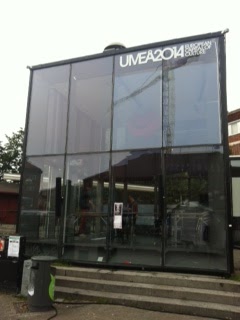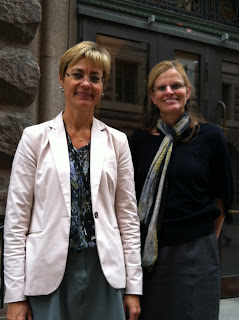Friday September 14 – Helsinki, Finland
I ended my fellowship in Finland with several key meetings today.
I had the opportunity to meet with Marcus Rantala, State Secretary for Defense at the Ministry of Defence in Helsinki. In addition to providing perspectives from his current position he offered insight from his previous position working at the Minister of Culture, Sport and Gender Equality Affairs.
The key takeaways from the meeting were the importance of leadership placing an emphasis on diversity and to have men championing the issue as well as women leaders. In Finland there was a time when both the Minister of Social Affairs and Equality and the State Secretary for that organization were men, which sent a signal that it isn’t just a women’s issue.
AmCham Finland
 |
| AmCham - Suvi, Alexandra, Kristiina, Carol, Nina |
The American Chamber of Commerce in Finland hosted a round table with several leading women in Finland
Kristiina Helenius, CEO AmCham Finland
Alexandra Pasternak-Jackson, Int’l Business Engagement, AmCham Finland
Suzanne Innes-Stubb, Counsel at White & Case, Chair of AmCham Women’s Network
Nina Kurth, Executive IBM Finland
Leena Munter, Director, Manpower Group
Suvi Sundquist, Safety and Security Programme Manager, TEKES
This was a wonderful wrap up to three weeks of various discussions. Collectively our group was quite diverse in type of industry, size of company, years of experience and international experience. All of the participants were passionate about the issue of growing and developing future leaders with an emphasis on women leadership. Several had multi-national experience and were able to compare and contrast women’s leadership in several regions.
A few key ideas/themes emerged: 1) Sponsorship is critical (active mentoring), 2) a diversity scorecard should be employed in the company and leaders should be held accountable for taking action on the soft skills just as they are on the financials and performance indicators and 3) developing a network is critical and since women are less likely to do this on their own leaders need to place emphasis on assisting in this, 4) Transparency – leaders need to discuss the plans to get a more diverse team and similar to Mr. Rantala’s perspective, men need to discuss and focus on the issue just as much as the female leaders.
The groups’ perspective on why there has been success in Finland was flexibility in the workplace, legislation has had an impact, and in many public and private sectors, Finland has recognized the need for balance. Collectively the group all felt that there was still progress to be made in developing more diverse teams in Finland, especially in the senior leadership ranks and in the technical industry.
Finland Eisenhower Fellows
I was hosted for lunch by two of Finland’s Eisenhower Fellows: Gunvor Kronman and Elisabeth Helander. It was nice to exchange ideas on how to continue the fellowship experience beyond the in-country time. They both shared perspectives on how to keep the exchange alive and have consequential outcomes.
My final appointment of the fellowship was with Tarja Filatov, Chairwoman, Finnish Parliament, Employment and Equality Committee. She shared her perspective on how women’s leadership has changed since the 1990’s and how various legislation has helped move the needle during that time, including a focus on daycare and legislation put in place by the Prime Minister to ensure that the political landscape had diversity. Tarja’s perspective is that there is still a need to improve diversity in the various labor markets as some are comprised entirely of women (social sector) and others are still highly concentrated with men (technical sectors).




































